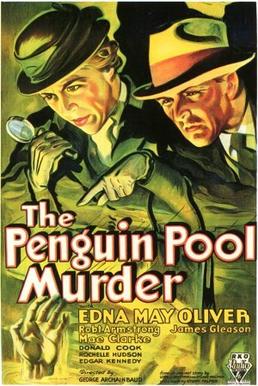Mae Clarke was an American actress. She is widely remembered for playing Henry Frankenstein's bride Elizabeth, who is chased by Boris Karloff in Frankenstein, and for being on the receiving end of James Cagney's halved grapefruit in The Public Enemy. Both films were released in 1931.
Mae Clarke was born in Philadelphia. Her father was a theatre organist. She studied dancing as a child and began on stage in vaudeville and also worked in night clubs. In 1922, at the age of 12, she marched in the Miss America Pageant Parade on the Atlantic City Boardwalk dressed as a lobster. She returned to the Boardwalk Parade again in 1940 as a featured guest, riding atop a white limousine convertible. Clarke started her professional career as a dancer in New York City, sharing a room with Barbara Stanwyck. She starred in many films for Universal Studios, including the original screen version of The Front Page (1931) and the first sound version of Frankenstein (1931), with Boris Karloff. Clarke played the role of Elizabeth, Henry Frankenstein's fiancée, who is attacked by the Monster (Boris Karloff) on her wedding day.
The Public Enemy, released that same year, contained one of cinema's more famous (and frequently parodied) scenes, in which James Cagney pushes a half grapefruit into Clarke's face, then goes out to pick up Jean Harlow. The film was so popular that it ran 24 hours per day at a movie theatre in Times Square upon its initial release; four months after the premiere, The Hollywood Reporter informed readers that Clarke's ex-husband Lew Brice claimed to have seen the film more than 20 times (and at least twice per week) and that Brice "says he goes to see the scene wherein Mae Clarke gets hit in the eye with a grapefruit—and that it's a plazure!"
Clarke appeared as Myra Deauville in the 1931 pre-Code version of Waterloo Bridge. In the film, she portrays a young American woman who is forced by circumstance into a life of prostitution in World War I London; both the film and Clarke's performance were well received by the critics.
Clarke also appeared in the modest pre-Code Universal film Night World (1932), with Lew Ayres, Boris Karloff, Hedda Hopper, and George Raft. In 1933, she was the female lead in Fast Workers, John Gilbert's last film as a contracted MGM star, and Lady Killer with James Cagney and Margaret Lindsay. The same year, she and actor Phillips Holmes were in a single-car accident that left Clarke with a broken jaw and facial scarring. Those injuries, however, did not end her film career, for she remained a leading lady for most of the 1930s. She was, though, increasingly cast in productions with lower budgets that lacked the status of her earlier films. Then, by 1940, Clarke slipped into supporting roles, although she did have a few last leading roles later in the decade, notably as the heroine in the Republic serial King of the Rocket Men (1949). In the 1950s and 1960s, Clarke played uncredited bit parts in several notable films, including Singin' in the Rain, The Great Caruso, and Thoroughly Modern Millie. Her last screen appearance was in the 1970 film Watermelon Man.
On television, Clarke appeared in many episodic series, including General Hospital, Perry Mason and Batman. Clarke retired in 1970 and taught drama.
| Date of Birth | 16th August 1910 |
|---|---|
| Date of Death | 29th April 1992 |
| Age at Death | 81 Years |
| Zodiac Sign | Leo |
| Country | United States of America |
| Current City | Philadelphia |
| Birth Place | Philadelphia |
| Death Place | Woodland Hills |
| Nationality | United States of America |
| Citizenship | United States of America |
| Spouses | Lew Brice |
|---|
| Occupation | actor, television actor, film actor |
|---|















